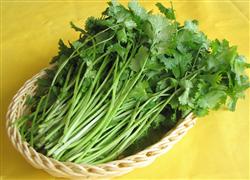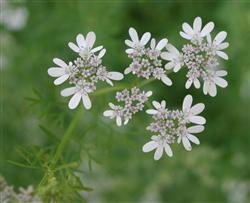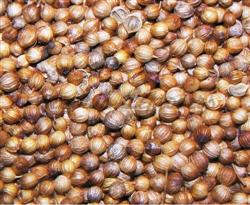Cilantro cultivation: what should be paid attention to in cilantro cultivation?

What should we pay attention to when growing coriander? Also ask experienced netizens to point out the matters needing attention in coriander planting, which are listed below for netizens' reference. 1. Suitable temperature for coriander planting: cilantro, also known as coriander, is a cold-tolerant vegetable with a suitable temperature of 12 ℃-26 ℃ for growth, but also has strong heat tolerance. Second, the requirement of coriander to the soil: the soil condition is not strict to the soil, but the loam with high organic matter content is more beneficial to the growth of coriander. Third, the treatment of the seeds before coriander planting: due to the hard shell of the seeds, the conventional method of sowing and emergence is slow. Before sowing, the seeds can be spread out on the flat ground and rubbed evenly and forcefully with less hard objects to break the shell. Then the seeds can be sowed directly (or soaked to accelerate germination). Generally, seedlings emerge about 8-13 days after sowing. Fourth, the variety selection of coriander: there are large leaf varieties and leaflet varieties. Large leaf varieties have high plant height, large leaves and high yield, while small leaf varieties have short plants, small leaves, strong aroma, cold tolerance, strong adaptability and slightly lower yield. There are many varieties of cultivated leaflets. Fifth, the planting method of coriander: 2000-3000 jin of farm manure per mu, 10 kg of diammonium phosphate and 10 kg of potassium sulfate. The use of strip sowing or sowing, strip sowing, sowing are covered with soil 2-3 cm, 3-4 jin per mu. Step on it with your foot after sowing, or suppress it with a leveling tool, and then water it to keep the soil moist to facilitate seedling emergence. At the same time, we should also pay attention to the phenomenon that the top of the seedling is not unearthed due to the soil consolidation before the coriander is unearthed, and check the seedlings in time after sowing. If the phenomenon of soil consolidation is found when the seedlings are unearthed, it is necessary to spray water to loosen the soil in order to help the young buds to grow normally. 6. the planting time of coriander: it can be planted in spring, summer and autumn, and the suitable sowing time in autumn is after the middle of August, and the production quality is better. Daily management after coriander planting: in order to create suitable growth conditions for coriander and achieve suitable temperature and humidity conditions, careful ploughing, soil loosening and weeding should be carried out for many times. When the seedlings grow to about 3 cm, the seedlings are interspersed and fixed. Generally, there are 2-3 times of ploughing, loosening soil and weeding during the whole growing period. At the top of the seedling soil for the first time, a light pickaxe or a small rake was used to slightly break the soil and loosen the soil to eliminate the plate layer. At the same time, unearthed weeds are pulled out to facilitate the growth of seedlings. The second time is carried out when the seedling height is 2-3 cm, and the strip sowing can be carried out with a small flat hoe to loosen the soil properly, combined with pulling out weeds. The third time is when the seedling height is 5-7 cm. In this way, early ploughing, loosening the soil and weeding can promote the vigorous growth of seedlings. After the leaves are sealed on the ground, no matter sowing or sowing, there is no longer ploughing and loosening the soil, but attention should be paid to pulling out weeds. 8. Water management of parsley: parsley is not drought-tolerant and should be watered gently every 5-7 days, basically during the growth period of the whole plant, 5-7 times to keep the soil moist. In the middle stage of growth, about 10 kg of urea per mu is applied to ensure good growth. Click to get more coriander planting techniques click to get more vegetable planting techniques
- Prev

Coriander planting: how to manage coriander after the Beginning of Autumn?
How to manage coriander after the Beginning of Autumn? What should I pay attention to? Also asked netizens to help guide general the Beginning of Autumn, coriander planted in the open field began to enter the peak season, farming network sorted out the matters that should be paid attention to after the establishment of autumn, listed below for netizens' reference. Pay attention to one, prevent parsley bolting: summer.
- Next

Coriander planting skills: soaking seeds in warm water makes coriander sprout quickly
Cilantro planting skills: fast sprouting of coriander seeds on a flat ground, rub the parsley seed evenly and slowly with soles or other flat objects, crack the shell of the parsley into a small mouth (do not crush it), soak the coriander seed in warm water of 30ml 45 degrees for 3 days before sowing. The incense has been broken and soaked in warm water.
Related
- Where is it suitable to grow horseradish in China? it is expected to see the middle altitude horseradish in Alishan.
- How to prevent tomato virus disease reasonably? (Control methods included)
- Many people like to plant towel gourd on the balcony. What are the main points of this method and management?
- What crops can chili peppers be mixed with?
- Fertilization techniques and matters needing attention in Tomato
- What are the grafting techniques for peach seedlings in spring?
- Harm and control methods of root swelling disease of Chinese cabbage
- What are the pests of sweet potatoes? How to prevent and cure it?
- Symptoms, causes and Control methods of navel Rot in Tomato
- The cause of "Cucumber rotten bibcock" in Farmers' planting Cucumber and its Control Plan

